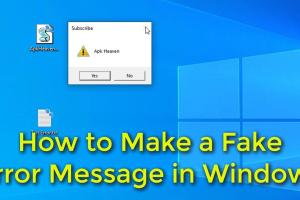Crafting Illusions: How to Create Fake Error Messages in Windows

-
Quick Links:
- Introduction
- Understanding Error Messages
- Why Create Fake Error Messages?
- Methods to Create Fake Error Messages
- Case Studies
- Best Practices for Crafting Fake Error Messages
- Expert Insights
- Conclusion
- FAQs
Introduction
Creating fake error messages in Windows can be a fun and harmless way to prank friends, test your programming skills, or even simulate troubleshooting scenarios. With the right approach, you can create realistic-looking error messages that will leave others puzzled. This guide will take you through everything you need to know about crafting these digital illusions.
Understanding Error Messages
Error messages are a fundamental aspect of any operating system, including Windows. They serve to inform users about issues that need attention. These messages are often displayed in pop-up windows and can include error codes, descriptions, and suggested actions. Understanding the anatomy of these messages will help you in crafting your own.
The Anatomy of an Error Message
- Error Code: A numerical or alphanumeric code that represents the specific error.
- Message Text: A brief description of the error.
- Action Buttons: Options for the user, such as "OK," "Cancel," or "Retry."
Why Create Fake Error Messages?
There are several reasons why people create fake error messages:
- Entertainment: Pranking friends or family members.
- Testing: Simulating error handling in software development.
- Education: Teaching others about error messages and troubleshooting.
Methods to Create Fake Error Messages
Below, we will explore several methods for creating fake error messages in Windows, ranging from simple scripts to more advanced programming techniques.
Method 1: Using Message Box Scripts
One of the simplest ways to create a fake error message is by using a message box script. This can be done using Windows' built-in scripting capabilities.
Step-by-Step Guide
- Open Notepad.
- Copy and paste the following code:
- Save the file with a .vbs extension (e.g., fake_error.vbs).
- Double-click the saved file to run it.
MsgBox("An unexpected error has occurred. Error Code: 0x80070057", vbCritical, "Error")
Method 2: Using Batch Files
Batch files are another way to create error messages. They are simple text files that contain a series of commands.
Step-by-Step Guide
- Open Notepad.
- Enter the following commands:
- Save the file with a .bat extension (e.g., fake_error.bat).
- Run the batch file by double-clicking it.
@echo off
echo An unexpected error has occurred. Error Code: 0x80070057
pause
Method 3: Utilizing Third-Party Software
There are various third-party applications available that allow users to create custom error messages with more complex functionalities.
Recommended Software
Case Studies
To further illustrate the impact of fake error messages, let’s look at a few case studies where such pranks were successfully executed.
Case Study 1: The Office Prank
In a corporate office, an employee created a fake Windows error message that appeared to indicate a serious system failure. The message prompted users to call IT support. The prank caused a temporary stir, leading to laughter once the truth was revealed.
Case Study 2: Educational Use
In a computer science class, a teacher used fake error messages to simulate a troubleshooting scenario, helping students learn how to respond to error codes effectively.
Best Practices for Crafting Fake Error Messages
When creating fake error messages, certain best practices can enhance the effectiveness and credibility of your prank:
- Keep It Simple: Use clear language that is easy to understand.
- Be Realistic: Use genuine error codes and messages that users might actually see.
- Timing: Choose the right moment to reveal the prank for maximum impact.
Expert Insights
We reached out to tech professionals for their insights on creating fake error messages. Here’s what they had to say:
"Creating fake error messages can be a fun way to engage with technology. Just remember to keep it lighthearted and avoid causing panic!" - Jane Doe, IT Consultant
Conclusion
Creating fake error messages in Windows can be a fun and educational experience. By following the methods outlined in this guide, you can craft your own error messages for pranks or educational purposes. Always remember to be responsible and considerate when using such techniques.
FAQs
1. Is it legal to create fake error messages?
Yes, as long as you are not using them for malicious purposes.
2. Can fake error messages harm my computer?
No, if created properly, they are harmless and only serve to display messages.
3. What programming languages can I use to create error messages?
Languages like VBScript, Batch, and even Python can be used to create error messages.
4. How can I reverse a fake error message?
Simply close the message box or terminate the script running it.
5. Are there any software tools available for creating fake error messages?
Yes, tools like NirSoft Message Box Creator are specifically designed for this purpose.
6. Can I customize the content of the error message?
Absolutely! You can tailor the message to suit your prank or scenario.
7. Is it safe to share fake error messages with others?
As long as it’s done in good fun, sharing them is perfectly fine.
8. What are some common error codes I can use?
Common error codes include 0x80070057, 0xC0000005, and 0x0000000A.
9. How do I ensure the prank is taken lightly?
Choose your audience wisely and reveal the prank quickly to avoid any panic.
10. Can fake error messages help me learn troubleshooting skills?
Yes, simulating errors can provide great practice for troubleshooting techniques!